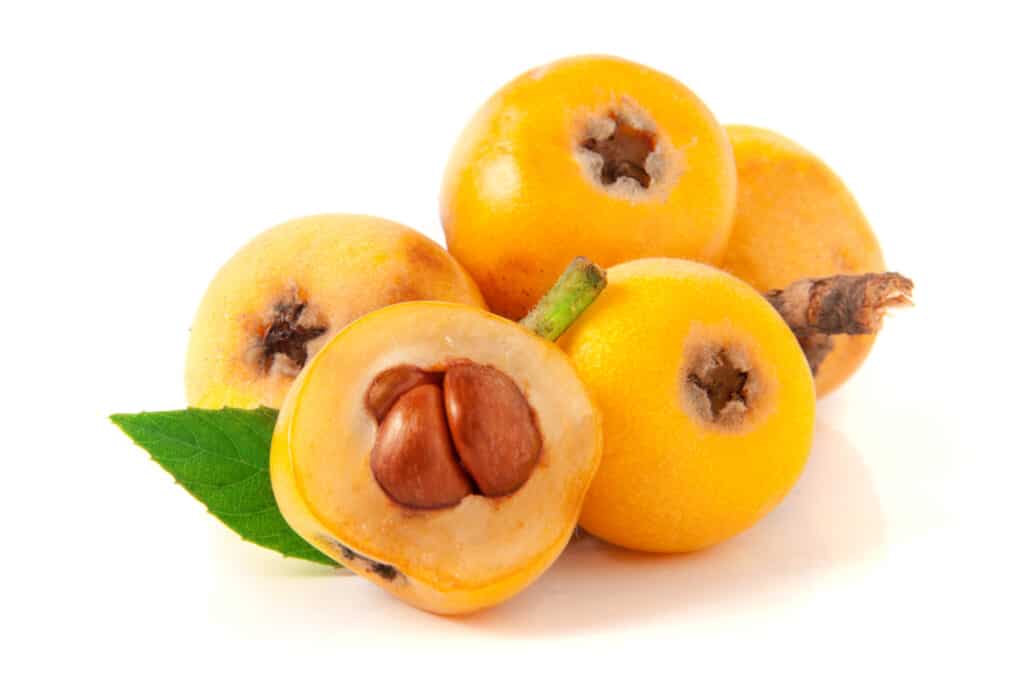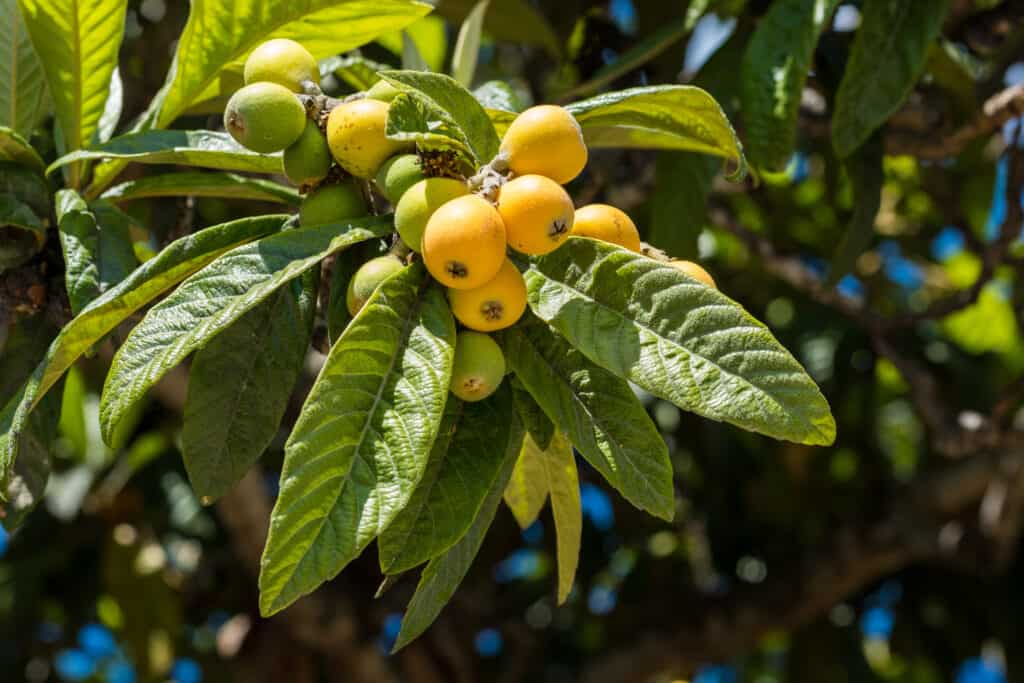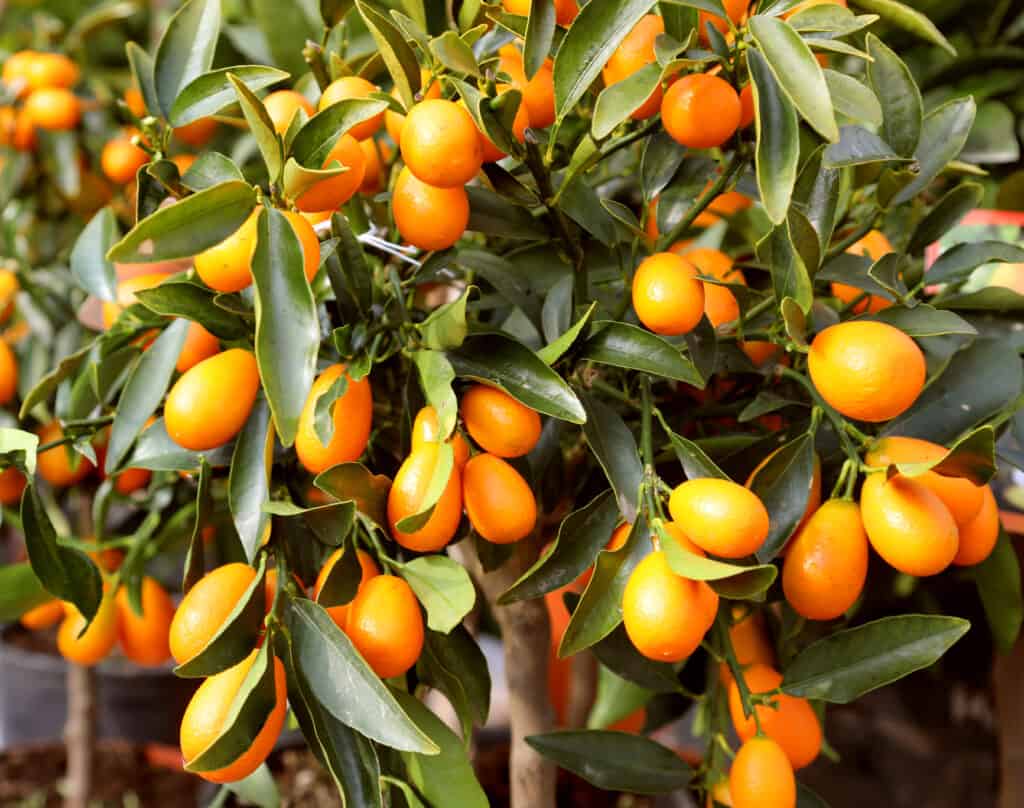Loquats and kumquats sound as if they’re related, but they’re not. In fact, aside from their similar-sounding names and the fact that they’re both fruit, they’re very different in most respects. In fact, comparing loquats and kumquats is akin to comparing apples and oranges!
In this article, we will compare loquats and kumquats so you can understand both fruits better. We will explain how they look, how they taste, and the plants they grow on. Plus, we’ll explain the nutritional benefits of both fruits so you can choose which one — or both — you would like to add into your diet.
Comparing Loquats and Kumquats
| Loquat | Kumquat | |
|---|---|---|
| Classification | Eriobotrya japonica, over 800 different varieties of loquat. As members of the Rosaceae family, so they are related to apples, pears, peaches, and nectarines. | Their taxonomy is in question. Previously, they were classified as Fortunella or Citrus, sensu lato. They have been assigned to C. japonica. Today, they are classified as Citrus hindsii, C. margarita, and C. crassifolia. A fourth variety, x japonica, is a hybrid of C. margarita and C. crassifolia. They are related to the citrus family. Fruit producers in the US have produced hybrids by crossing kumquats with other citrus fruits such as mandarin oranges and limes. |
| Plant Description | It has large glossy green leaves on the upper side and a rust or white color on the underside. Its flowers develop in the late fall or in winter. By spring, the fruit is mature and looks round or pear-shaped, similar to a plum. Depending on the variety, mature plants can grow to 25 feet tall and about 15 feet wide. | Depending on the subspecies, these shrubs or trees can mature to 8 to 12 feet tall. Their leaves are dark green on top and lighter on the underside with pure white flowers. |
| Fruit Description | Loquats can be round, pear-shaped, or oval and range from 1 – 2 inches, depending on the variety. They have tough, yellow to bronze skin and three to four large seeds. Their flesh can be white or orange, again, depending on the variety. They are pleasingly tart, much like plums, cherries, and other plants in this family. | Kumquats have bright orange-yellow fruit is oval or round (1 inch in diameter). The skin is pulpy and sweet. Different varieties may be round or egg-shaped and they vary in size. |
| Uses* | In Chinese medicine, loquats are used to treat respiratory and digestive problems. You can also eat loquats on their own (the skin and flesh are edibile) or in pies or jelly. | Kumquats are generally enjoyed in candy or in marmalades or jellies. Kumquat tree branches are often used as Christmas decorations, especially in the United States. |
| Taste | Sweet tropical flavor, can also be slightly bitter depending on the variety | Slightly sweet with a sour or tangy taste |
| Origin | They are native to central-eastern China and were first introduced to Japan over 1,000 years ago. | This fruit originates in Asia and later was cultivated in Japan. Since it is typically grown in warm climates, it can be grown anywhere warm, including in the United States, Puerto Rico, and South America. |
| Growth Tips | They can be grown in areas where citrus doesn’t traditionally grow, which means there is minor upkeep and they are relatively low maintenance. They can thrive in most types of soil and climates. | Kumquat shrubs/trees require a minimum of six to seven hours of direct sunlight, which helps them develop their roots. However, eight to 10 hours is ideal. This fruit matures in late November. |
| Fun Facts | Loquats are used to make plum wine. They can live for over 50 years. | The word kumquat means “golden orange” or “tangerine” in Chinese. These fruit were first mentioned in the 12th century in Chinese literature |
Key Differences Between Loquats and Kumquats
There are many differences between loquats and kumquats. For example, loquats require much less sun and attention than the more high-maintenance kumquat. Loquats cannot withstand frigid temperatures, but kumquats can. Let’s review some of the other differences between these two fruits now.

Loquats can be round, pear-shaped, or oval, depending on the variety, and they range from 1 to 2 inches in length.
©Nataly Studio/Shutterstock.com
Classification
The loquat (Eriobotrya japonica) or Japanese plum belongs to the Rosaceae family, which includes fruits such as nectarines, pears, apples, and peaches. There are over 800 different varieties of loquat.
The classification of kumquats is far less straightforward. In the past, kumquats were classified as Fortunella or Citrus, sensu lato. In fact, some research material still (erroneously) classifies kumquats as Fortunella. Today, botanists classify kumquats as Citrus hindsii, C. margarita, and C. crassifolia. You will also find a fourth variety,
They have been assigned to C. japonica. Today, they are classified as Citrus hindsii, C. margarita, and C. crassifolia. A fourth variety, x japonica, which is a hybrid of C. margarita and C. crassifolia. Kumquats belong to the Rutaceae family and are considered to be cold-hardy citrus plants.
Description
In terms of size, kumquats are much smaller than loquats, about the size of a small orange or large olive. Kumquat trees also tend to be about ⅓ of the size of loquat trees. Loquats develop round, pear-shaped, or oval fruit in a variety of colors (depending on the cultivar). While kumquats are also oval or round, they’re considerably smaller than loquats and comes only in shades of orange.

Kumquats are related to citrus fruits, but their taxonomy isn’t so straightforward.
©iStock.com/bergamont
Uses
Both fruits are consumed on their own, in jelly or marmalade, or in candy. Loquats are filled with antioxidants like beta carotene that help protect the body from disease. Beta carotene can help treat infection, allergies, diabetes, and different cancers because of its ability to help reduce inflammation in the body. Loquats are also high in vitamin A. Kumquats are also full of antioxidants as well as fiber and vitamins C and A. Consuming these nutrients can aid digestion and strengthen the immune system.
Taste
Loquats have different flavors depending on their subspecies. Some taste like a tangerine, an apricot, a pear, or even a mango. In general, the best way to describe them is a tropical fruit with a hint of citrus. Kumquats have a slightly sweet taste combined with a sour or tangy flavor, depending on the variety.
You can safely eat both skins of both fruits. They also both have seeds inside their fruit, which when consumed in large amounts can lead to symptoms such as nausea and shortness of breath. Because of this, you should remove the seeds before consumption.

Loquat leaves are large and glossy green on the upper side and rust or white on the underside.
©iStock.com/kornyeyeva
Origin
Loquats have been produced for over a thousand years in Japan and in colder parts of China. Lately, they have been grown for decorative purposes in California and other coastal plain areas.
Originating in China, the kumquat was later cultivated in Japan, too, much like the loquat. Today, it is also grown in warm climates in the United States like Florida, California, or Texas as well as in South America and Puerto Rico.
Growth Tips
Loquats thrive in different climates and soils while the kumquat grows best in slightly acidic soil. What’s key for any citrus plant is hydration, especially the first few years of a plant’s life. Keep the roots moist. Applying mulch over its roots helps the plant to maintain moisture without developing root rot.
Kumquats can benefit from liquid fertilizer. To avoid burning your plant, since it requires so much direct sunlight, water it well before and after using any fertilizer.

Kumquat leaves are dark green on top and lighter on the underside.
©iStock.com/ChiccoDodiFC
Loquats vs. Kumquats: Fun Facts
Loquats were first mentioned in the poems of Li Bai, a Chinese poet who was a member of a group of Chinese scholars known as the Eight Immortals of the Wine Cup. Kumquats were first introduced to Europe in the mid-1800s by Robert Fortune, a collector for the London Horticultural Society. Soon after, they were brought to North America where they grow in warm regions today.
What’s Next:
- 7 Extinct Fruits
- The 10 Largest Citrus Fruits
- The 12 Best Fruit Trees to Grow in Texas: Plus 3 Helpful Growing Tips
The photo featured at the top of this post is © Nataly Studio/Shutterstock.com
Sources
- Orlando Sentinel, Available here: https://www.orlandosentinel.com/news/os-xpm-2007-03-25-orsimply25-story.html
- Frontiers in Plant Science, Available here: https://www.frontiersin.org/articles/10.3389/fpls.2022.867659/full
- Wikpedia, Available here: https://en.wikipedia.org/wiki/Kumquat
Thank you for reading! Have some feedback for us? Contact the AZ Animals editorial team.






